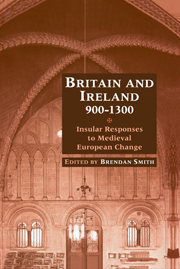Book contents
- Frontmatter
- Contents
- Contributors
- Preface
- List of abbreviations
- 1 The effect of Scandinavian raiders on the English and Irish churches: a preliminary reassessment
- 2 The changing economy of the Irish Sea province
- 3 Cults of Irish, Scottish and Welsh saints in twelfth-century England
- 4 Sea-divided Gaels? Constructing relationships between Irish and Scots c. 800–1169
- 5 The 1169 invasion as a turning-point in Irish-Welsh relations
- 6 Killing and mutilating political enemies in the British Isles from the late twelfth to the early fourteenth century: a comparative study
- 7 Anglo-French acculturation and the Irish element in Scottish identity
- 8 John de Courcy, the first Ulster plantation and Irish church men
- 9 Coming in from the margins: the descendants of Somerled and cultural accommodation in the Hebrides, 1164–1317
- 10 Nobility and identity in medieval Britain and Ireland: The de Vescy family, c. 1120–1314
- Bibliography
- Index
10 - Nobility and identity in medieval Britain and Ireland: The de Vescy family, c. 1120–1314
Published online by Cambridge University Press: 30 July 2009
- Frontmatter
- Contents
- Contributors
- Preface
- List of abbreviations
- 1 The effect of Scandinavian raiders on the English and Irish churches: a preliminary reassessment
- 2 The changing economy of the Irish Sea province
- 3 Cults of Irish, Scottish and Welsh saints in twelfth-century England
- 4 Sea-divided Gaels? Constructing relationships between Irish and Scots c. 800–1169
- 5 The 1169 invasion as a turning-point in Irish-Welsh relations
- 6 Killing and mutilating political enemies in the British Isles from the late twelfth to the early fourteenth century: a comparative study
- 7 Anglo-French acculturation and the Irish element in Scottish identity
- 8 John de Courcy, the first Ulster plantation and Irish church men
- 9 Coming in from the margins: the descendants of Somerled and cultural accommodation in the Hebrides, 1164–1317
- 10 Nobility and identity in medieval Britain and Ireland: The de Vescy family, c. 1120–1314
- Bibliography
- Index
Summary
As Rees Davies has re-emphasized, ‘the length of the Matter of England needs to be balanced in some degree by the breadth of the Matter of Britain’. But as its leading exponents also readily admit, ‘British history’ rarely lends itself to neat conceptual frameworks; and for the medievalist it is often unusually difficult to devise serviceable organizing principles. In the twelfth and thirteenth centuries our terms of reference seem to lie conveniently to hand in the apparently remorseless growth of the English state, in its deliberate cultivation of an intensified sense of English political and cultural individuality, and in the supposed ‘unity’ of baronial society in Britain and Ireland. Yet we must remind ourselves once again that, however passionately the Westminster-centred government believed otherwise, defining the contours of power and identity in these islands was not solely its prerogative. This chapter is about the experience of belonging to a baronial family whose territories ultimately spread from England into Scotland, Wales and Ireland. It is concerned with how its members reacted to their varied surroundings and sought to defend and promote their interests; with their loyalties, priorities and values; and with the complexities and contradictions of their identity and self-image. Its main purpose, however, is to contribute to the discourse of ‘British history’ through an attempt, as Sir Frank Stenton once put it, ‘to penetrate behind the abstraction to the individual’.
- Type
- Chapter
- Information
- Britain and Ireland, 900–1300Insular Responses to Medieval European Change, pp. 199 - 239Publisher: Cambridge University PressPrint publication year: 1999

